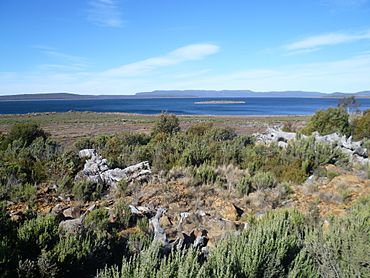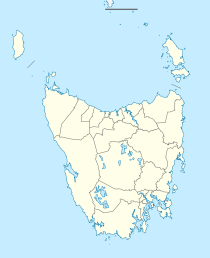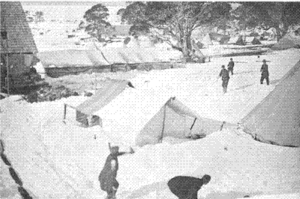Liawenee facts for kids
Quick facts for kids LiaweneeTasmania |
|||||||||
|---|---|---|---|---|---|---|---|---|---|
 |
|||||||||
| Population | 2 (2011 census - Miena Dam incl. Liawenee) | ||||||||
| Established | 11 June 1920 | ||||||||
| Postcode(s) | 7030 | ||||||||
| Elevation | 1,065 m (3,494 ft) | ||||||||
| Location | 122 km (76 mi) NNW of Hobart | ||||||||
| LGA(s) | Central Highlands Council | ||||||||
| State electorate(s) | Lyons | ||||||||
| Federal Division(s) | Lyons | ||||||||
|
|||||||||
Liawenee (/laɪ.əˈwiːni/) is a tiny town in Tasmania, Australia. It sits close to Great Lake and the River Ouse. The town was started on June 11, 1920.
Liawenee used to be a village for workers from Hydro Tasmania. This company builds and runs power plants that use water. Today, it's home to staff from the Inland Fisheries Services (IFS) and a Tasmania Police station. The town is famous for its amazing fishing in Great Lake. It often hosts special events for trout fishing.
Did you know Liawenee is the coldest place in Australia where people live all the time? In January 2020, the town's population grew to two people. These are a police officer and an IFS officer who live there permanently.
The Story of Liawenee
The name Liawenee comes from a word used by Aboriginal Tasmanians. It means "frigid," which means very, very cold. The town began in June 1920. It was a camp for people working on a big hydroelectric project nearby. Other towns like Miena were also part of this project.
At first, only the workers and their families lived in Liawenee. Their homes were simple, made of wood and canvas. There were three small cottages for married couples. There was also a "hospital" that was really just a first-aid clinic. The camp had important places like blacksmiths, bakeries, and a store for animal feed. It was more of a work camp than a proper village.
During the Second World War, Liawenee grew bigger. Many men lived there, working hard. But there wasn't much to spend their money on, and mail delivery was difficult.
Liawenee had a post office twice. The first one opened in October 1919 and closed in 1922. The second one opened in February 1948 but closed in 1953. Today, Liawenee has a police station and a few small buildings.
Where is Liawenee?
Liawenee is found along the Lake Highway. This road winds through the central mountains of Tasmania. The mountains around Liawenee include Split Rock and McDowall Hill. McDowall Hill is the tallest.
Liawenee is the twelfth-highest place in Tasmania. The closest ocean beach is about 100 kilometres (62 miles) to the west-south-west. The area's rough land is great for bushwalking and mountain biking. But it's too cold for these activities in winter. The nearest town is Miena, about 13 km south. The road to Miena was paved in 2015.
Liawenee's Climate
Liawenee is high up in southern Australia. This gives it a special climate. It has a rare cold-summer mediterranean climate (Köppen climate classification: Csc). It's also close to an oceanic climate (Cfb) and a subpolar oceanic climate (Cfc).
Even in February, which is summer, temperatures are only between 5 °C (41 °F) and 18 °C (64 °F). This is colder than most Australian winters in the south. Sometimes, a northerly wind makes temperatures rise into the mid-twenties. But it rarely gets into the thirties.
The coldest day ever recorded was on July 9, 1997. The temperature didn't go above −2.0 °C (28.4 °F). The lowest temperature ever in Tasmania was recorded in Liawenee. It was −14.2 °C (6.4 °F) on August 7, 2020. This was also the lowest temperature in Australia for 2020. Even in summer, days can be cold. The coldest summer day was 5.0 °C (41.0 °F) on December 3, 2017.
Liawenee only has about 0.7 days a year above 30 °C (86 °F). But it has about 210 days below 2 °C (36 °F). And 142 of those days are below freezing!
The town has about 136 cloudy days each year. July is the cloudiest month with 16 days. January has the fewest cloudy days, about 8. It rains or snows on about 182 days each year. The air is often humid, especially in July. Snowfall happens often and can be heavy. It snows on about 41 days a year, and snow can fall in any month.
Liawenee and nearby Miena Dam are among the coldest places in Australia where people live. This is based on their average highest daily temperatures. Liawenee's average highest temperature is 12.1 °C (53.8 °F). This is colder than other high places in mainland Australia.
| Climate data for Liawenee (2001–2022); 1,057 m AMSL; 41.90° S, 146.67° E | |||||||||||||
|---|---|---|---|---|---|---|---|---|---|---|---|---|---|
| Month | Jan | Feb | Mar | Apr | May | Jun | Jul | Aug | Sep | Oct | Nov | Dec | Year |
| Record high °C (°F) | 32.3 (90.1) |
31.2 (88.2) |
28.6 (83.5) |
22.9 (73.2) |
20.1 (68.2) |
14.5 (58.1) |
12.0 (53.6) |
17.1 (62.8) |
18.5 (65.3) |
25.3 (77.5) |
27.4 (81.3) |
31.2 (88.2) |
32.3 (90.1) |
| Mean daily maximum °C (°F) | 19.1 (66.4) |
18.2 (64.8) |
16.0 (60.8) |
12.3 (54.1) |
9.0 (48.2) |
6.6 (43.9) |
5.6 (42.1) |
6.5 (43.7) |
9.0 (48.2) |
11.9 (53.4) |
14.9 (58.8) |
16.5 (61.7) |
12.1 (53.8) |
| Daily mean °C (°F) | 12.4 (54.3) |
11.7 (53.1) |
10.0 (50.0) |
7.1 (44.8) |
4.7 (40.5) |
2.8 (37.0) |
2.0 (35.6) |
2.6 (36.7) |
4.3 (39.7) |
6.4 (43.5) |
8.9 (48.0) |
10.2 (50.4) |
6.9 (44.5) |
| Mean daily minimum °C (°F) | 5.6 (42.1) |
5.2 (41.4) |
3.9 (39.0) |
1.8 (35.2) |
0.3 (32.5) |
−1.0 (30.2) |
−1.6 (29.1) |
−1.3 (29.7) |
−0.4 (31.3) |
0.8 (33.4) |
2.8 (37.0) |
3.9 (39.0) |
1.7 (35.0) |
| Record low °C (°F) | −4.0 (24.8) |
−3.6 (25.5) |
−6.9 (19.6) |
−7.7 (18.1) |
−10.5 (13.1) |
−11.2 (11.8) |
−12.2 (10.0) |
−14.2 (6.4) |
−10.7 (12.7) |
−7.9 (17.8) |
−6.8 (19.8) |
−4.5 (23.9) |
−14.2 (6.4) |
| Average precipitation mm (inches) | 49.6 (1.95) |
40.0 (1.57) |
63.5 (2.50) |
66.1 (2.60) |
87.1 (3.43) |
100.5 (3.96) |
115.9 (4.56) |
127.8 (5.03) |
104.9 (4.13) |
81.4 (3.20) |
62.3 (2.45) |
57.2 (2.25) |
925.6 (36.44) |
| Average precipitation days (≥ 0.2 mm) | 9.1 | 9.4 | 11.9 | 12.9 | 16.1 | 17.3 | 19.1 | 20.3 | 17.3 | 16.1 | 14.1 | 12.7 | 176.3 |
| Average afternoon relative humidity (%) | 49 | 51 | 55 | 65 | 69 | 77 | 78 | 74 | 68 | 61 | 53 | 54 | 63 |
| Average dew point °C (°F) | 4.9 (40.8) |
5.5 (41.9) |
4.7 (40.5) |
3.6 (38.5) |
1.8 (35.2) |
1.1 (34.0) |
0.5 (32.9) |
0.4 (32.7) |
0.7 (33.3) |
1.5 (34.7) |
2.9 (37.2) |
4.0 (39.2) |
2.6 (36.7) |
| Mean monthly sunshine hours | 297.6 | 245.8 | 235.6 | 180.0 | 139.5 | 105.0 | 120.9 | 161.2 | 201.0 | 232.5 | 261.0 | 272.8 | 2,452.9 |
| Source: Bureau of Meteorology | |||||||||||||



